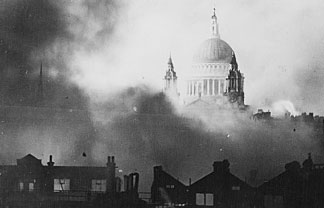Αthena Syriatou
The City in Crisis and the Construction of the People:
The London Blitz and the Memory of the Second World War

From 7 September 1940 until 21 May 1941, the Nazi Luftwaffe bombed London, along with sixteen other British cities, in 71 separate air attacks. These attacks, however, failed to defeat the British government, to damage the economy or destroy the British war machine or even London itself. They also failed to break the spirit of resistance and the resilience of London’s population, although the raids exposed huge social differences and the various malfunctionings of the government.
Various aspects of life pushed to the fore the struggles of the populace on the ‘home front’, as it was termed colloquially. Such aspects included, among many other matters, improvised air-raid shelters in London suburban back gardens, the transformation of the London Underground into a huge air-raid shelter, bombed-out Buckingham Palace, posters placed around London conveying messages from the coalition government to the populace and the use of Hyde Park for agricultural purposes.
Indeed, for the greater part of the post-war period, the ‘home front’ formed the foundation of society’s image of itself as one that acted in a uniquely patriotic spirit and so was rewarded with the creation of the Welfare State.
Journalists, artists and historians employed the memory of the Home Front, replete with emblematic images of a city populace that faced the barbarity of the enemy with endurance, courage and even humour, to create the idea of the ‘People’s War’, in which the various social classes of Britain accepted each other and the intrinsic virtues of the British character emerged. However, the degree to which the experience of the Blitz did in fact contribute to the elimination of social disparities and societal conflict and to the creation of a united British people is a highly contested issue for historians of the post-war period in Britain.
Αθηνά Συριάτου
Η κρίση της πόλης και η κατασκευή του λαού:
Ο βομβαρδισμός του Λονδίνου και η μνήμη του πολέμου

Από τις 7 Σεπτεμβρίου 1940 έως τις 21 Μαΐου 1941 το Λονδίνο, μαζί με δεκαέξι άλλες πόλεις της Βρετανίας, βομβαρδίστηκε από τη ναζιστική αεροπορία σε 71 αεροπορικές επιθέσεις.
Οι επιθέσεις αυτές δεν κατάφεραν να κάμψουν ούτε τη βρετανική κυβέρνηση ούτε και την οικονομία και τη βρετανική πολεμική μηχανή, ούτε καν έφεραν την καταστροφή της πρωτεύουσας. Πολύ περισσότερο δεν έκαμψαν το πνεύμα αντίστασης και αυτοοργάνωσης του πληθυσμού, παρόλο που οι βομβαρδισμοί αυτοί έδρασαν σε μεγάλο βαθμό ως καταλύτης για την ανάδειξη των τεράστιων κοινωνικών διαφορών και της δυσλειτουργίας της κυβέρνησης.
Τα καταφύγια στους κήπους των σπιτιών στα προάστια, ο υπόγειος του Λονδίνου που μετατράπηκε σε καταφύγιο, το βομβαρδισμένο παλάτι, τα μηνύματα της συμμαχικής κυβέρνησης προς το λαό σε αφίσες στους δημόσιους χώρους, η αγροτική εκμετάλλευση του μητροπολιτικού πάρκου και πλήθος άλλων αλλαγών στη ζωή της πόλης ανέδειξε τον πόλεμο στα μετόπισθεν, κατά τη διάρκεια της μεταπολεμικής περιόδου, ως τον θεμέλιο λίθο της αυτοεικόνας της κοινωνίας ως μιας κοινωνίας που έδρασε ενωμένη και δικαιώθηκε με τη δημιουργία του κράτους πρόνοιας.
Η μνήμη του «πολέμου στα μετόπισθεν» (home front), με τις εμβληματικές εικόνες του λαού που με εγκαρτέρηση και θάρρος, ακόμα και με ευθυμία, αντιμετώπισε τη βαρβαρότητα μέσα στην πόλη, χρησιμοποιήθηκε από δημοσιογράφους, καλλιτέχνες, ακόμα και ιστορικούς για τη σμίλευση της ιδέας του «πολέμου του λαού», όπου οι κοινωνικές τάξεις αναγκάστηκαν να συμφιλιωθούν, ενώ αναδείχθηκαν οι αρετές του βρετανικού χαρακτήρα.
Το κατά πόσο όμως τα βιώματα της πόλης στη διάρκεια του βομβαρδισμού όντως σήμαναν και τη λείανση, πόσο μάλλον την εξάλειψη, των κοινωνικών συγκρούσεων στη διάρκεια της κρίσης, παραμένει ένα κεντρικό ερώτημα της μεταπολεμικής ιστορίας της Βρετανίας.